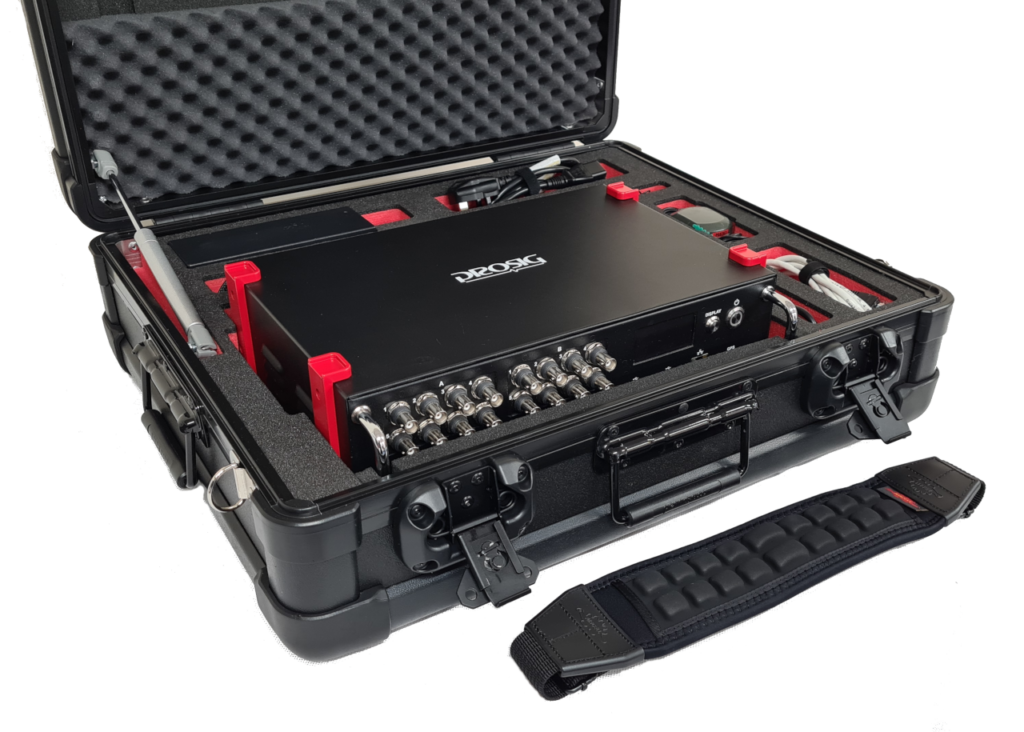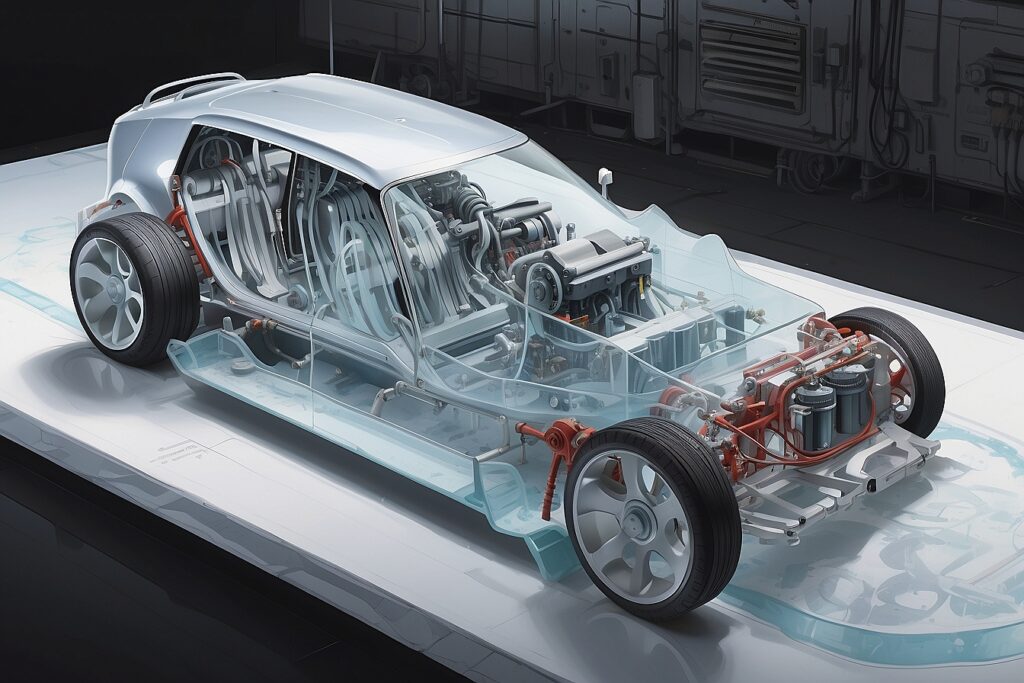[An Introduction To Vibration Analysis – Part 5]
Welcome to Part 5 of our ongoing introduction to the world of vibration and acoustic measurement and analysis. Here, we look specifically at the techniques and tools used to look at vibration in rotating machines.
Introduction: The Critical Role of Analysis of Vibration in Rotating Machines
Vibration Analysis: The Unsung Hero in Machinery Maintenance
In the world of industrial engineering, the analysis of vibration in rotating machines plays a pivotal role. It’s like tuning into the subtle whispers of machines to preemptively address potential failures. This is especially crucial in the context of ICE (Internal Combustion Engine) engines, EV (Electric Vehicle) powertrains, steam turbines, and various types of pumps. For seasoned engineers, understanding these vibrations isn’t just about preventing breakdowns; it’s about optimizing performance and enhancing vehicle refinement.
Characterizing Vibrations: Listening to the Language of Machines
Decoding the Vibrations: From ICE Engines to EV Powertrains
- ICE Engines: The heartbeat of countless industries, ICE engines exhibit unique vibrational patterns. These patterns can reveal everything from fuel efficiency issues to potential mechanical failures. By analyzing these vibrations, engineers can fine-tune engines for optimal performance.
- EV Powertrains: The new kids on the block, EV powertrains, present a different set of challenges. Their vibrations are less pronounced than ICE engines but are equally crucial for diagnosing issues like electrical imbalances or rotor misalignments.
- Steam Turbines: The workhorses of power generation, steam turbines, have their language of vibration. By understanding these patterns, engineers can predict and prevent issues like blade fatigue or shaft misalignment.
- Pumps: Often overlooked, pumps are critical to many industrial processes. Vibration analysis here can reveal problems like cavitation, impeller damage, or bearing wear.
Identifying Common Faults: The Key to Preventative Maintenance
Unmasking the Culprits: Imbalance, Misalignment, and Bearing Defects
- Imbalance: A primary cause of vibration in rotating machines, imbalance occurs when the centre of mass is not aligned with the axis of rotation. This can lead to excessive wear and tear and even catastrophic failures.
- Misalignment: When components are not perfectly aligned, the resulting vibrations can decrease the efficiency and lifespan of machinery. This is especially critical in high-speed applications like turbines.
- Bearing Defects: Bearings are the unsung heroes of rotating machinery, and their failure can lead to significant downtime. Vibration analysis can detect early signs of bearing wear or damage, allowing for timely maintenance.
Advertisement
COMPLEXITY MADE SIMPLE
From sensors to DAQ to analysis & reporting, Prosig supports your entire measurement chain



Whether you need accelerometers from our colleagues at DJB Instruments, microphones, pressure sensors or something else, Prosig can supply them as part of your system. Or you can use your own. Discover more about the Prosig hardware and software range.
Vehicle Refinement: Elevating the User Experience Through Vibration Control
The Art and Science of Smooth Operation
- Noise, Vibration, and Harshness (NVH) in Vehicles: In the automotive world, NVH is a key component of vehicle refinement. Reducing vibrations not only enhances the comfort of the ride but also contributes to the longevity of the vehicle.
- In Electric Vehicles: EVs bring a different NVH challenge, as the lack of engine noise makes other vibrations more noticeable. Engineers must work meticulously to ensure that vibrations from the powertrain and ancillary systems are minimized.
- Advanced Diagnostic Techniques: Modern vibration analysis techniques, such as spectral analysis and modal analysis, offer engineers sophisticated tools to diagnose and resolve vibration-related issues, ensuring that vehicles are not just functional but also refined.
Delving Deeper: Advanced Techniques and Technologies in Vibration Analysis
The Cutting Edge of Vibration Diagnostics
- Spectral Analysis and Its Evolution Spectral analysis has long been a cornerstone of vibration analysis, enabling the breakdown of complex vibration signals into their constituent frequencies. This technique allows for the precise identification of specific mechanical issues, such as gear tooth defects, unbalance, misalignment, and electrical issues in motors. The latest advancements in spectral analysis involve enhanced signal processing algorithms that can isolate and identify even the most subtle anomalies in vibration data, allowing for earlier detection of potential issues.
- Operational Deflection Shape (ODS) Analysis Operational Deflection Shape (ODS) Analysis is a powerful tool for visualizing the movement of an entire machine or structure under operational conditions. It helps in understanding how different components of a machine behave in relation to each other and under various load conditions. This understanding is crucial for diagnosing complex vibration issues that might not be apparent from traditional vibration data alone. The integration of 3D modelling and visualization technologies has further enhanced the capabilities of ODS analysis, providing more intuitive and detailed insights into machine dynamics.
- Modal Analysis and Its Applications Modal analysis complements ODS by determining the natural frequencies, mode shapes, and damping characteristics of a machine or structure. This technique is especially valuable for understanding how a machine will respond to different types of forces and for diagnosing resonance issues. Advances in sensor technology and data processing have enabled more accurate and comprehensive modal analysis, even in complex industrial environments.
Case Studies: Real-World Applications of Analysis of Vibration in Rotating Machines
Success Stories from the Field
- Resolving Imbalance in Large Turbines: A Power Plant’s Triumph In a prominent power plant, engineers faced recurring issues with one of their main steam turbines. The turbine exhibited increased vibration levels, leading to concerns about its long-term reliability and efficiency. Vibration analysis was deployed to investigate the issue. Through spectral analysis, the team discovered that an imbalance in the turbine’s rotor was causing the excessive vibrations. This imbalance was traced back to uneven erosion on the turbine blades, a common problem in steam turbines over time. By precisely balancing the rotor and repairing the eroded blades, the plant not only reduced the vibration levels significantly but also improved the overall efficiency and lifespan of the turbine. This intervention prevented potential catastrophic failure and costly downtime, showcasing the power of proactive vibration analysis.
- Diagnosing Bearing Failures in Pumps: Saving an Industrial Process In an industrial facility, a series of pumps used for critical fluid transfer processes began showing signs of wear. The maintenance team noted an unusual increase in vibration levels and noise from one of the pumps. Utilizing vibration analysis, they were able to pinpoint the issue to a failing bearing. The analysis revealed that the bearing’s deterioration was due to a combination of factors, including misalignment and inadequate lubrication. By addressing these root causes and replacing the bearing, the facility avoided a major failure that could have halted the entire process. This case highlights the importance of vibration analysis in identifying not just the symptoms, but also the underlying causes of machinery problems.
- NVH Optimization in Electric Vehicles: Enhancing Passenger Comfort A leading automotive manufacturer, while developing a new model of electric vehicle, faced challenges with unexpected vibration and noise levels. These issues were critical, as electric vehicles, with their inherently quieter operation, make other noises and vibrations more noticeable and potentially uncomfortable for passengers. The engineering team employed advanced vibration analysis techniques, including modal and operational deflection shape analysis, to identify the sources of the noise and vibration. It turned out that the motor mountings and the interaction between the battery pack and the vehicle’s chassis were contributing to the problem. By redesigning these components and employing targeted vibration damping measures, the manufacturer was able to significantly reduce NVH levels, leading to a quieter, smoother ride. This case study demonstrates the vital role of vibration analysis in the pursuit of vehicle refinement, particularly in the evolving landscape of electric vehicle design.

These case studies, based on real scenarios, illustrate the practical applications and benefits of vibration analysis in various industries. They underscore the importance of this technique in not only preventing failures but also in optimizing machinery performance and product quality.
The Future of Vibration Analysis: Trends and Innovations
Embracing Tomorrow’s Technologies Today
- Integration with the Internet of Things (IoT) The integration of vibration analysis with IoT technology represents a significant leap forward. Sensors embedded in machinery can continuously collect vibration data and transmit it wirelessly for real-time monitoring. This enables the shift from periodic maintenance to a more efficient predictive maintenance approach, where potential issues are identified and addressed before they lead to failure.
- Artificial Intelligence and Machine Learning in Vibration Analysis AI and machine learning algorithms are increasingly being utilized to interpret vast amounts of vibration data. These technologies can identify patterns and anomalies that would be impossible for humans to detect, leading to more accurate diagnoses and predictions. The use of AI in vibration analysis not only improves the efficiency of maintenance routines but also helps in optimizing machine performance over time.
- Wireless and Remote Monitoring Solutions The advent of wireless sensor technology and remote monitoring has revolutionized vibration analysis by facilitating the continuous surveillance of machinery health from anywhere in the world. This is particularly beneficial for industries with machinery located in remote or hazardous environments. Engineers can now diagnose and resolve issues without the need for physical presence, reducing response times and maintenance costs.
- Advanced Data Visualization Tools Data visualization plays a key role in interpreting vibration analysis data. Advanced tools and software now offer interactive 3D models and intuitive dashboards, making it easier for engineers to understand complex vibration data and make informed decisions. These tools also facilitate better communication of technical information across different levels of an organization, enhancing collaborative problem-solving efforts.
- Customized Solutions for Specific Industry Needs Recognizing that each industry has unique requirements, vibration analysis technology is increasingly being customized for specific applications. For instance, in the wind energy sector, vibration analysis tools are tailored to monitor the health of wind turbine blades and gearboxes, while in the automotive sector, they focus more on NVH levels and powertrain efficiency.
Conclusion: The Future of Vibration Analysis in Rotating Machinery
Embracing Technology for Enhanced Machinery Health
The field of rotating machinery vibration analysis is not just about maintenance; it’s about embracing innovation for optimal performance and reliability. As technology evolves, so do the methods of diagnosing and addressing vibration-related issues. For engineers in this field, staying ahead means continuously learning and adapting to these changes. It’s a journey of discovery, where each vibration holds the key to a deeper understanding of these mechanical marvels.
In summary, analysis of vibration in rotating machines, encompassing ICE engines, EV powertrains, steam turbines, and pumps, is a crucial aspect of modern engineering. Identifying and addressing common faults like imbalance, misalignment, and bearing defects not only prevents machinery failures but also contributes to the overall refinement of vehicles. As technology advances, the scope and efficacy of vibration analysis are set to reach new heights, ensuring that our machines continue to operate smoothly and efficiently.
Further Reading
- “Machinery Vibration Analysis Fundamentals” by John S. Mitchell
- “Rotating Machinery Vibration: From Analysis to Troubleshooting” by Maurice L. Adams
- “Vibration Analysis for Electronic Equipment” by Dave S. Steinberg
- “Practical Machinery Vibration Analysis and Predictive Maintenance” by Cornelius Scheffer and Paresh Girdhar
- “Introduction to Machinery Analysis and Monitoring” by John S. Mitchell
- “Dynamics of Rotating Machines” by Michael I. Friswell et al.
See the whole Basic Signal Processing series
Feedback and discussions are encouraged in the comment section. Dive deep, analyze thoroughly, and remember – in every oscillation, there’s information waiting to be decoded.
Latest posts by Chris Mason (see all)
- Rotating Machinery Vibration Analysis: Keeping Your Machines Humming Along - November 27, 2023
- Vibration Control and Isolation: A Comprehensive Guide for Engineers - November 6, 2023
- Modal Analysis in the Real World - October 6, 2023



